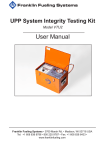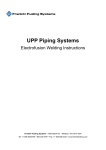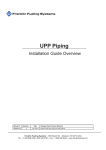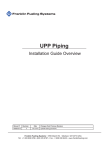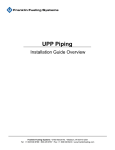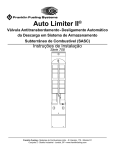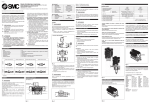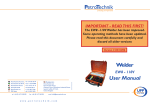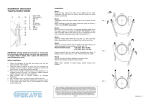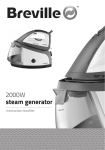Download Cable-Tight™ Wire Management System Installation Guide
Transcript
Cable-Tight™ Wire Management System Installation Guide Franklin Fueling Systems • 3760 Marsh Rd. • Madison, WI 53718 USA Tel: +1 608 838 8786 • 800 225 9787 • Fax: +1 608 838 6433 • www.franklinfueling.com Safety Important! UPP™ Systems must only be installed by fully trained and certified installers. Failure to follow installation instructions will invalidate warranty and installer certification! Piping Installation Safety • UPP™ Welding Units must never be operated in Zone 1 or Zone 0 areas (Hazardous area definitions are from European Directive 1999/92/EC and guidelines can be found in the APEA Blue Book 3rd Edition). • Ensure Welding Units are connected to a power supply that meets the requirements detailed in the user manual and are within the requirements of any local authority or regional legislation. • Important to any type of piping system is to safely connect all metallic components to ground. Metallic components, and more general conductive materials, due to their high capacitance, can have the potential to store high amount of electrostatic energy (sparks discharge can only be observed over conductive elements). • All exposed metal parts used in UPP™ System installations should be adequately grounded to a dedicated earth electrode and brought to a potential equal to that of other metal parts in the close proximity. Chemical Safety Where using chemicals (such as Acetone) during the installation of UPP™ systems products, follow all safety guidelines given on the chemical containers themselves or on any accompanying literature. Confined Space • Some installation of UPP™ products may occur in confined spaces where a lack of oxygen and a concentration of toxic vapors is likely to be experienced. • Such working conditions are dangerous and all local health and safety guidelines for working in such environments should be followed. Protective Equipment • Ensure the correct personal protective equipment (PPE) is used at all times in line with local health and safety requirements. Material Safety Data • Ensure all safety data is accessed and used while installing UPP™ Systems Transport & Storage • UPP™ products should be transported and stored in accordance with guidelines contained in this manual. Heavy items • Heavy items should be handled using suitable lifting equipment operated by authorised personnel. Visually inspect all components before use to confirm there is no sign of damage. Installation of ducting should be installed following UPP™ Systems Pipework Installation Instructions. 2 Cable-Tight™ Wire Management System General Information The Cable-Tight™ Wire Management System provides a means of securely routing electrical conduit to and between sumps / chambers and sealing the entries against vapor and water intrusion. Removable Separation The chamber can be fitted with an optional removable metal segregation panel that separates the IS (Intrinsically safe ) wiring from the high voltage wiring by creating two compartments. Part number for the Segregation Panel is 408109001. Removable Panel Creates Two Compartments Installation Installation of the electrical containment coincides with the pipework and follows installation of the sumps/ chambers. Install the Transition Chamber Position the transition chambers in accordance with local regulations. Ensure correct burial depth to provide drainage away from the chamber. Transition Chamber Preparation Prepare the area for the installation of the chamber taking into account the burial depth for the desired finished surface level. Anchor the electrical transition chamber with wood or angle iron or most commonly set into concrete to position it correctly Feet on chamber allow secure mounting in concrete Pre-marked drill centres Top View of Transition Sump Figure 2: Removable Panel The transition chamber connects ducting from the kiosk / control console to the conduit from the sumps / chambers. Ensure that the vapour seal to the kiosk is leak-tight. Where required by local regulations, ensure the duct termination at the kiosk is terminated more than 1 meter above ground level. Limit of concrete, front and back Figure 1: Transition Sump • Pre-marked drill centres allow optimized placement of UPP™ entry seals in the side walls. • Entry seals can be mounted before installing the transition sump. (Follow electrofusion fitting installation instructions). From Kiosk / Console To Sumps / Chambers Figure 3: Transition Sump Connections Frame Bolt Gasket Draw Pit Backing Plate Connection detail Figure 4: Sump Installation Detail 3 Installing Entry Seal Fittings Incorrect selection or installation of seal or seal plugs can lead to loss of containment and may lead to transfer of flammable vapours. 1. 2. 3. 4. 5. Measure the diameter of each cable and ensure they are fitted into the correct holes of the Entry Seal. The entry seal (303-075-EC) is first installed with the compression nut removed following electrofusion guidelines Lightly attach the compression nut on the threads of the entry seals. Pull all wires / cables though to their final location. Unscrew the compression nuts and let the nut rest on the cables. Follow instructions on Figures 5 through 9. Figure 8: Push Entry Seal into the Entry Fitting Figure 9: Tighten Compression Nut Figure 5: Spread Cables and Insert Compression Disk (See Table 1) Tighten the compression nut hand-tight plus an additional ½ turn using a strap wrench, chain wrench or one as shown in Figure 10. Approved cable lubricant or liquid soap may be used on the vapor gland to assist positioning the cables and tightening the lock nut. Below are show two styles of wrenches that can be used to tighten the compression nuts. Figure 10: Compression Nut Wrenches Figure 6: Tilt the Compression Disk to Insert Cables Caution: Do NOT over-tighten the compression nut. Over-tightening of the compression nut will cause it to break. Unused channels must be fitted with cable plugs. Cable plugs are available to insert into unused channels in the vapor seal. Refer to Figure 7 and table 3 Figure 7: Insert Plugs If required, insert plugs into unused channels prior to tightening the compression nut. 4 Figure 11: The 32 mm Conduit Entry Seal fittings are installed similarly to above. Select the required Vapour Seal from Table 2. Parts Tables Image Part Number 408102001 408103001 408113001 408122001 Number of Holes x Cable Diameter (approximate) 2 x 14-17 mm 1 x 11-14 mm 2 x 9-12 mm 12 x 5-8 mm 3 x 12-15 mm 6 x 7-10 mm Blank Typical Location Dispenser Power and Data (Non I. S.) Tanks (I .S.) Tank Power (Pressure Only) Line Testing and Future Expansion 2 x 408029001 1 x 408131001 2 x 408132001 408134001 3 x 408130001 6 x 408133001 N/A 5 5 5 5 Corresponding Plug: Quantity x Part number Pack Size Table 1: Multi-Cable Compression Disks Image Part Number 408107006 408107005 408107004 408107003 408107002 408107007 Grommet Size 6 mm, (3) 9 mm 11 mm 14 mm 16 mm Blank Cable diameter (approximate) mm 5 - 6 7- 9 9 - 11 12 - 14 14 - 16 N/A Pack Size 10 5 5 5 5 10 Table 2: Compression Grommets Image Part Number 408128001 408129001 408130001 408131001 408132001 408133001 408134001 Grommet Size 25 mm 16 mm 14 mm 12 mm 11 mm 9 mm 6 mm Pack Size 10 10 10 10 10 10 10 Table 3: Plug Table Select the correct size of compression disk or compression grommet when replacing these items. Follow Installation Instructions. 5 Installation 303-2DBC Entry 2 x direct-buried cable Ensure that the cables are buried at depths as required by local regulations. Note: Grommets are sold separately 1. Determine the location of the entry seal and install it following electrofusion guidelines. Installation 302-DBC Entry direct-buried cable Note: Ensure that the cables are buried at depths as required by local regulations. Note: Grommets are sold separately 1. Determine the location of the entry seal and install it with the compression nuts removed, following electrofusion guidelines. Figure 12: Entry Seal for the 303-2DBC Measure cable Ø and select the proper size of grommets for cable size (refer to table 2). Figure 13: 303-2DBC Assembly 2. Route the first cable through entry seal, housing grommet and compression nut. 3. Repeat with second cable. Tighten the compression nuts hand tight plus an additional ½ turn using a strap or chain wrench. Note: For a second seal on the cables , the backside of the housing can be potted inside the housing before electrofusion sealing “in” entry seal. Figure 14: 302-DBC Entry Seal Measure cable Ø and select the proper size of grommets for cable size (refer to table 2). Figure 15: 302-DBC Assembly 2. Route the cable first through the compression nut and grommet and then through the entry seal, 3. Pass cable through 2nd grommet and compression nut. Tighten the compression nuts hand tight plus an additional ½ turn using a strap or chain wrench. 4. Position the housing into entry seal so that the threaded face is flush with entry seal. Weld housing into entry seal following electrofusion guidelines. Figure 16: 302-DBC Assembled 6 Installation 305-3X27MM-CON Entry 27 mm Rigid Conduit Vacuum Testing 1. Determine the location of the entry seal and install it following electrofusion guidelines. The UPP™ Vacuum Test Unit VTU2 can be used to test the joint between electrical chamber and all entry seals. Recommended test setting: 1 ft: -30 mbar. Refer to the Model VTU2 System Integrity Testing Kit Operation manual. Note: Make sure plugs and blanks (see tables 1&2) are positioned in entry seals and sealed. Inside Outside PE Wall Entry Seal Figure 17: Entry Seal without Housing 2. Position housing into entry seal so that threaded face is flush with entry seal. Weld housing into entry seal following electrofusion guidelines. Inside Outside UPP System Integrity Testing Unit Figure 20: Vacuum Testing Electrical Transition Sump IMPORTANT: Inspect all entry seals, vapour seals and plugs to ensure all parts a correctly fitted and sealing nuts hve been tightened. Final Backfilling ( Electrical Transition Chamber) Prior to backfilling the Access Cover must be in position to prevent any deflection of the Chamber Flush Figure 18: Entry Seal with Housing Installed Route rigid conduit at an axial alignment to Entry Seal of no greater than ± 5 degrees through the housing and then the grommet. Secure conduit in position by tightening the nut. Hand-tighten nuts plus an additional ½ turn using strap wrench Housing Outside Grommet Nut Acceptable backfill materials are: • Well-rounded pea gravel, size 3 mm (⅛") to 20 mm (¾"). • Crushed rock size 3 mm (⅛") to 16 mm (⅝"). • Clean washed sand. Particular care should be taken to ensure that enough backfill is laid down around the underside of the access cover frame with enough concrete to fully support the frame to withstand traffic loading. IMPORTANT:Backfill material should fully support UPP™ pipe-work and be free from ice or organic silt or peat, which could disappear over time causing voids or possible ground movement. No mechanical compactors should be used such as vibrating plates, compactors or road rollers. Inside Figure 19: Entry Seal with Conduit Installed Note: If any opening are not used, seal with 25 mm plug 408128001 in the grommet. 7 Franklin Fueling Systems LTD 8 Olympus Close • Whitehouse Industrial Estate Ipswich, Suffolk IP1 5LN • United Kingdom Tel: +44 1473 243300 • Fax: +44 1473 243301 ©2015 FFS 408123001 Rev 1








